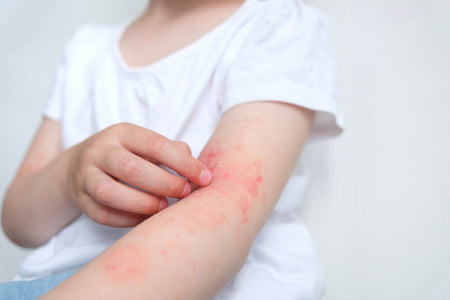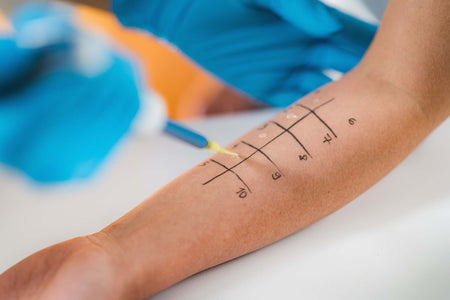- Grass rash is a common condition caused by skin contact with grass pollen.
- It can appear on the skin as red, inflamed patches with itching and sometimes small bumps.
- Avoiding grass and using medications for relief are ways to manage it.
Imagine having a picnic on a lush green lawn. As you sit back and relax, you notice an unusual itching and redness on your skin, which has spread and become more uncomfortable as the day progresses. If this sounds familiar, you might be dealing with a grass rash.
It might sound strange that grass can cause a rash, but it happens more often than you'd think, as many people are actually allergic to grass pollen. Grass rash can also occur due to other factors.
We’ll discuss them in this article, including common symptoms, diagnosis, treatment strategies, and when to see a doctor.
What is Grass Rash?
Grass rash is a skin irritation that occurs after contact with grass, usually on exposed areas like the arms, legs, and feet. It results in an uncomfortable reaction. The intense itching sensation caused by grass rash can lead to a strong urge to scratch the affected areas, which can worsen the rash.
A grass rash is a common issue experienced by individuals who spend time outdoors, particularly in grassy areas. The condition can vary in severity depending on the individual’s sensitivity and the type of grass they come into contact with (e.g., Bermuda and Kentucky grasses).
What Does Grass Rash Look Like?
Grass rash typically presents as red, inflamed patches on the skin, often accompanied by small bumps or blisters. The affected areas may appear swollen and vary in size, sometimes forming a pattern that mirrors the contact with the grass. The rash usually has a rough or raised texture and can be intensely itchy.
For a clearer understanding of what to look for, grass rash pictures help identify and differentiate the rash from other skin conditions.

What Causes Grass Rash?
Several factors can contribute to the development of a grass rash. They include exposure to grass pollen, contact dermatitis, and sensitive skin or an existing skin condition.
Here’s a more detailed explanation:
Grass pollen
Grass pollen is a fine powder produced by grasses during their reproductive phase. It’s easily carried by the wind, even from locations far away from where you are. This means you can experience grass pollen allergy symptoms even if the grass near your home is not the culprit — the pollen may be coming from other locations [*].

Image source: Allerma
Contact dermatitis
Direct contact with certain types of grass can cause irritation or an allergic reaction. Contact dermatitis can be caused by exposure to certain types of grass, either through direct irritation from the physical grass itself or associated chemicals (such as fungicides) [*].
Sensitivity or an existing skin condition
People with highly sensitive skin may be more reactive to the physical irritation caused by the microscopic bristles on grass blades, leading to a rash upon contact. Moreover, those with eczema are more likely to experience a grass rash upon exposure.
Being able to identify your triggers and avoid them is important for managing grass rash.
What are the Symptoms of Grass Rash?
The main symptoms of a grass rash include:
- Redness
- Skin itching
- Small, raised bumps or hives
- Localized swelling
- Dryness or peeling
These symptoms can vary in intensity depending on the individual’s sensitivity to grass pollen or other allergens, the duration of exposure, and any pre-existing skin conditions.
How is Grass Rash Diagnosed?
Skin prick allergy testing can be done to identify if the patient is allergic to grass pollen. A positive result, indicated by a raised bump (wheal) and redness (flare) will show at the test site. Blood tests may also be performed to measure your levels of grass-specific IgE antibodies, which indicate an allergy.
If you suspect you may have a grass allergy that is causing a grass rash, the best course of action is to speak to your healthcare provider or a board-certified allergist and get properly tested. Don’t try to self-diagnose or manage it alone.
How is Grass Rash Treated?
Grass rash is typically treated by managing the symptoms and reducing exposure to the allergen. Treatment options include:
Avoidance of grass pollen
It helps to check pollen count forecasts regularly, especially during peak grass pollen seasons. On days with high grass pollen levels, limit the time you spend outdoors. In case you need to mow the lawn or do other yard work, wear a face mask.
To keep grass pollens out of your home, keep your windows and doors closed and consider air conditioning instead. Some homeowners use HEPA air purifiers to filter grass pollen from indoor air.
If you plan to have a picnic or go hiking outdoors, wear protective clothing that provides a barrier between your skin and the grass.
Topical steroids
Topical anti-inflammatory steroids can help calm the redness, itchiness, and swelling associated with a grass rash. Applying these medications directly to affected areas can help suppress the immune response of inflammation and relieve discomfort.
The most common example includes hydrocortisone cream, which is available over-the-counter, and often known as “anti-itch cream.” Prescription-strength options like triamcinolone acetonide or betamethasone valerate are also available by prescription only.
Oral Antihistamines
Antihistamines can help manage grass rash by blocking the action of histamine, a chemical released by the immune system during allergic reactions to grass pollen.
Reducing histamine’s effects can help alleviate symptoms of grass rash.
Examples include cetirizine, loratadine, and fexofenadine, which are available over the counter and by prescription. These medications can be used regularly or as needed to manage grass allergy effectively.
Remember, always consult your healthcare provider before starting a new medication.
Related: Decongestant vs. Antihistamine
Cold compress
A cold compress can be an effective home remedy for providing relief from the symptoms of a grass rash. It works by reducing inflammation and providing a cooling sensation to irritated skin.
Simply soak a clean cloth or towel with ice cubes or cold water and wring out any excess moisture. Apply the cold compress directly to the affected areas of the grass rash. Alternatively, you can take a cool shower or bath.
Moisturizers
Moisturizers hydrate the skin and form a protective barrier that can reduce irritation and itching. Choose moisturizers that are hypoallergenic and fragrance-free as they can be beneficial for individuals with sensitive skin prone to allergies.
Nasal sprays
While nasal sprays are not the primary treatment for grass rash, they are most useful when the grass rash is accompanied by nasal symptoms like congestion, runny nose, sneezing, or itchy/watery eyes.
Nasal sprays are often used in conjunction with other topical and oral treatments to provide comprehensive relief for all grass allergy symptoms.
If you're looking for an effective solution to manage your grass allergy nasal symptoms, consider trying Allermi.
Allermi treats inflammation of the nose (rhinitis) using up to 4 active ingredients in one Super Spray: oxymetazoline (decongestant), azelastine (antihistamine), ipratropium (anti-discharge), and triamcinolone (anti-inflammatory).
Targeting the source of allergic reactions to grass pollen allows nasal sprays to provide effective relief and improve overall nasal congestion and discomfort.
Related: How to Unstuff Your Nose Instantly
Allergy shots
Allergy shots, also known as subcutaneous immunotherapy (SCIT), can be an effective long-term treatment option for managing grass allergies that may contribute to skin rashes.
They involve regular injections containing small amounts of the allergen (in this case, grass pollen) over a period of years. The goal is to gradually desensitize the immune system and reduce the allergic response to grass pollen.
Consult with an allergist to determine if allergy shots are an appropriate treatment option for you.
Related: What to Do When Allergy Medicine Doesn’t Work
How Long Does Grass Rash Last?
Mild cases of grass rash generally resolve within a few hours to a couple of days, especially if treated promptly with over-the-counter remedies like topical steroids and antihistamines.
However, reactions that are more severe may take longer to heal and could require medical intervention to manage symptoms effectively. If a grass rash worsens or does not improve, consulting your healthcare provider would be recommended.
How to Prevent Grass Rash
Taking proactive steps to limit your exposure prevents or minimizes the occurrence of grass rash. Follow these grass rash prevention tips:
- When spending time outdoors, wear long sleeves, long pants, and gloves to minimize skin contact with grass.
- Shower after outdoor activities to remove pollen from your skin and clothing.
- Avoid outdoor activities during peak pollen times, typically in the morning and on dry, windy days. Try to plan outdoor activities for other times.
- Consider taking your allergy medications proactively before exposure to grass. It’s one of the ways to prevent allergic reactions to grass pollen [*].
- Regularly wash clothes and bedding to remove any pollen that may have settled on them.
When to See a Doctor for Grass Rash
You should see a doctor for grass rash if the rash is severe, covers a large area of your body, persists for more than a few days despite home treatments.
If the rash is significantly impacting your daily activities, seek medical attention promptly for proper evaluation and treatment.
If grass rash is accompanied by symptoms such as fever, difficulty breathing, or signs of infection (such as pus or increasing redness), seek urgent care.
The Bottom Line
Grass rash can be uncomfortable, inconvenient and happen more often than we think. Prevention is key to managing grass rash, and it includes simple steps like wearing protective clothing, showering after outdoor activities, and avoiding peak pollen times.
Remember to always seek advice from a doctor if preventive measures are not working well enough or if you experience severe symptoms.
References:
- Grass Pollen Allergy | AAFA.org. (2024, April 23). Asthma & Allergy Foundation of America. https://aafa.org/allergies/types-of-allergies/pollen-allergy/grass-pollen-allergy/
- Allergic contact dermatitis from a lawn care fungicide containing dyrene. (1997, March 1). PubMed. https://pubmed.ncbi.nlm.nih.gov/9066850/
- AAFA Community Services. (n.d.). Tips for preventing allergic reactions to tree and grass pollen. Asthma and Allergy Foundation of America. https://community.aafa.org/blog/tips-for-preventing-allergic-reactions-to-tree-and-grass-pollen









